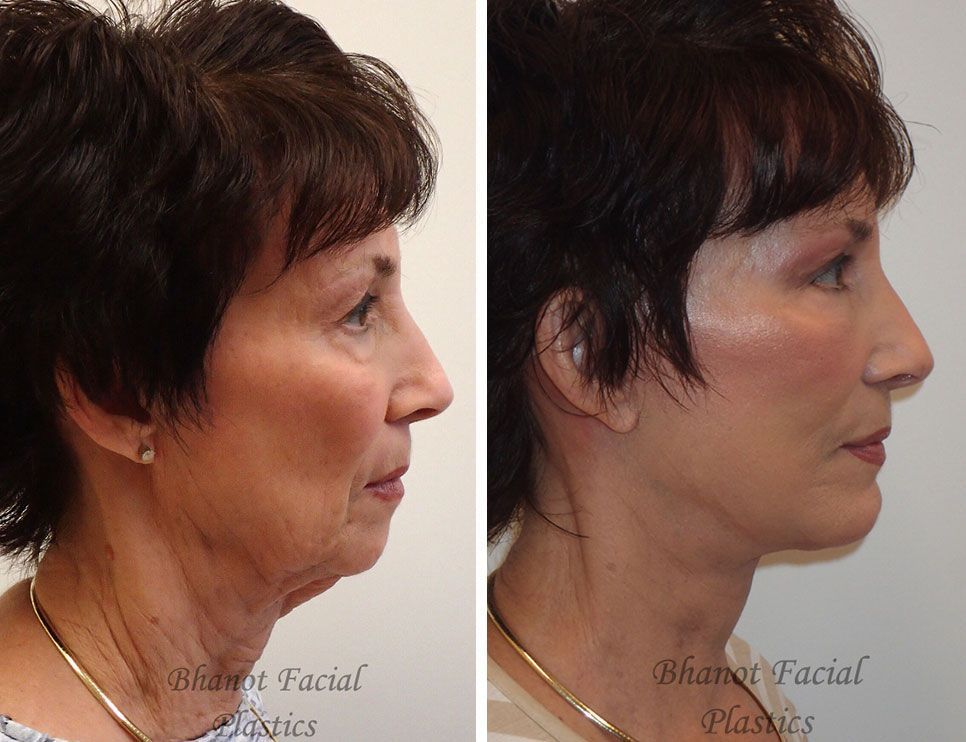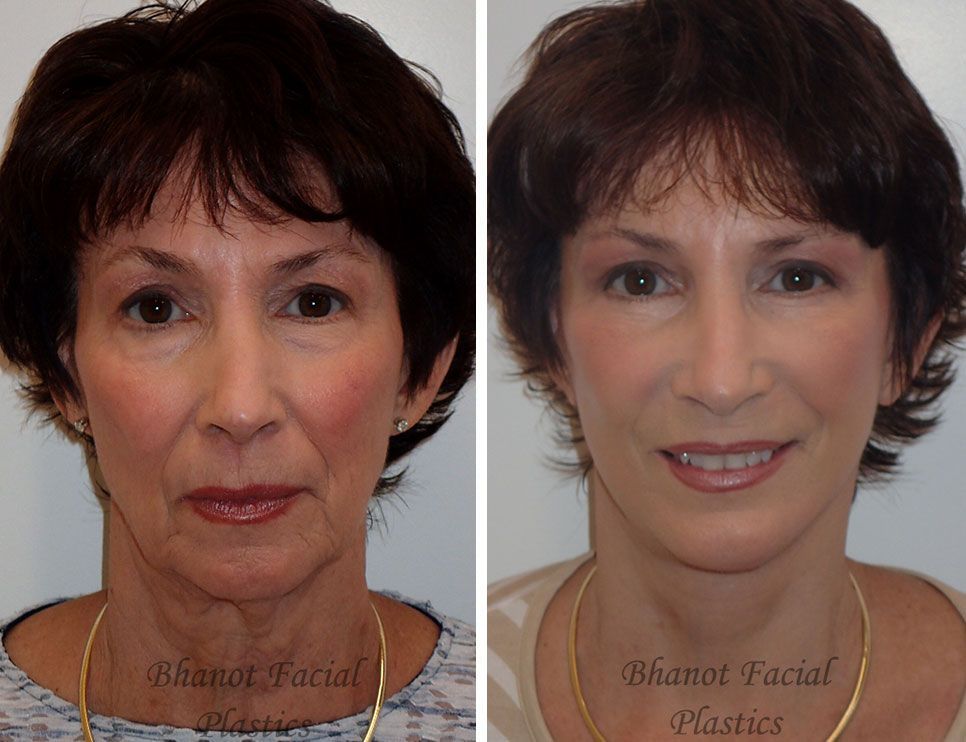Facelifts and Neck Lifts in Sarasota
Restore the Natural Anatomy of a Youthful Face
For over a decade, Bhanot Facial Plastic Surgery has specialized exclusively in Deep Plane Facelifts, delivering exceptional facelift and neck lift results. Every procedure is performed by Dr. Bhanot, who brings more than 20 years of experience and surgical expertise to every procedure.
To schedule a consultation about a facelift or neck lift, please call us today.
Deep Plane Facelifts
To understand what is accomplished by a facelift, we must first study the anatomy of the face and the effect of aging on the anatomy with time. Once we understand the aging process and how the face is supported, we can develop techniques that help reverse these changes.
The term "facelift" has been diluted by its use on quick shortcut procedures that distort the face, creating a very unnatural and often painful-to-look-at appearance. These procedures are not true facelifts, yet, unfortunately, they are given the same name. In addition to these misnomers, there is also the “liquid facelift” — here the term is being used to conjure up images of the youthful results of a facelift, accomplished with nothing more than fillers. In our opinion, we should use the term "facelift" only for those procedures that truly surgically address the aging process at a structural level.
The Anatomy of the Face
Facelifts can be broken down into three major categories. However, to understand the various types, we need to review the basic anatomy of the face.
The anatomy of the face as it relates to aging involves the various layers of the face and how it is built. The deepest structure is the skull (bone); this provides the scaffold that supports all the soft tissue. We then have the deeper muscles and fat compartments that provide fullness to the face. Beyond this layer is the fascia layer called the SMAS fascia. This fascia can be thought of as a canvas-type material that is strong and does not stretch. This envelops the face, holding the muscles and fat in place. How does this layer attach to the skeleton for support? This is perhaps the single most important concept in facelifts and how we can make them appear natural. There are ligaments that travel through all the layers of the face from the skeleton, through the soft tissue (fat and muscle), through the fascia, and to the skin. These cutaneous ligaments are numerous and are distributed in multiple areas of the face. Beyond the fascia layer is a layer of fat and the final layer of skin. The skin is elastic and can stretch, so it can be compared to a plastic bag.
As we age, the face sags, and as it sags, it remains tethered by the cutaneous ligaments that are present in the cheekbone area, side cheek, and chin. These tethers create standard aging changes. Many people believe that aging results from pure volume loss. That is not the entire story. In reality, the volume is not lost. It just falls to the center and lower parts of the face. The upper parts of the lower eyelid and upper cheek appear skeletonized and devoid of volume while all the volume piles up in the lower cheek and jowl area. The anchoring ligaments force the volume into these areas. Logically, if we could move this volume to its original location, that should solve the problem. Let us discuss how the facelifts are done.
Categories of Facelifts
There are three major categories of facelifts:
- Mini-lifts
- SMAS facelifts
- Deep plane facelifts
We will explore all three major categories to compare and contrast the technique, results, and efficacy.
The mini-lifts are advertised as being quick, easy, and done in-office with quick/minimal recovery. They promise fabulous results at a minimal cost. How are they done? Well, remember what your mom taught you — if it sounds too good to be true, it usually is! This facelift falls into that category. In essence, all they are doing in those 45 minutes to one hour is stretching the skin over the entire face. So, we take the plastic bag and pull it taut over the face. This creates a pulled appearance and does nothing for the fallen volume of the face. We are all too familiar with this undesirable look.
The second category of facelifts is the SMAS (fascia) facelifts. These facelifts move the fascia that helps support the deeper face, making it a much better facelift because the supporting structure of the face is addressed. While this facelift does a great job of tightening the neck and lower face, it fails in re-suspending the fallen volume of the face. The result is a decent neck, but the middle of the face appears unchanged. The midface appears full in the lower cheeks, yet the lower eyelid and upper cheek areas still appear sunken. Some surgeons address this by injecting fat or volume into the upper face. While this fills the upper face, it leaves the lower face unchanged. Essentially this creates a stacking of the volume and creates a very full and plump appearance to the face. So, we are just covering up a problem as opposed to fixing it. Can we do better?
The third category of facelifts is the very rare deep plane facelifts. These facelifts address the problem at the source. The reason the SMAS fails is that it does not release the cutaneous ligaments that create the sagging face look. This surgery is in a deeper plane of the face that allows for the release of the key ligaments to help move the volume back to the upper parts of the face. Once these ligaments are released, the fullness of the lower cheek and jowl is automatically lifted to the upper cheek area. We are not stacking the added volume; we are truly restoring the natural anatomy of the youthful face. Once the main hallmark of the aging face is corrected (i.e., the fallen volume), the rest just falls into place. This creates the face we once had 20 years ago and truly looks natural — because it is. The deep plane facelift does not require stretching out the skin to compensate for the inadequacy and limitations of the procedure as is true for the other two facelift techniques.
Our patients do not usually need convincing that this is the ultimate facelift. They can see the results for themselves. Dr. Bhanot has spent 20 years of his career evolving and perfecting this procedure and truly feels this is the best technique we have to offer.
Neck Lifts
The aging of the neck follows the aging of the face. In addition, two sheet-like muscles (platysma) separate in the central neck and create bands that are a common source of irritation for many patients.
Many surgeons offer neck lifts in isolation, separate from a facelift procedure. This can be performed, however, for most patients, several compromises don't make it worthwhile. An isolated neck lift will pull the neck skin behind the ears (straight back) and create creases in the area in front of the ear and accentuate the jowl. The problem here is that we are pulling in the wrong direction.
Our view is that the neck is intimately connected to the face. As the face volume falls, it falls into the neck, creating jowls that encroach onto the neck area. Therefore, the vast majority of patients that desire a neck lift truly need a facelift in addition. When performed with a facelift, we can pull the facial volume away from the neck and back into the face. This does not create any abnormal creases or compromised results. In our practice, a neck lift is included in the facelift procedure. For these reasons, it is not a separate procedure.
In rare instances, some patients have a sagging neck while in their thirties. This is genetic and can be addressed separately without the need for a facelift because, in this age group, the facial volume has not fallen into the neck and, therefore, does not need to be addressed.
Part 1
BLOOM Daily Health & Lifestyle TV Show on WFLA News Channel 8, April 2024
Part 2
BLOOM Daily Health & Lifestyle TV Show on WFLA News Channel 8, April 2024
Part 3
BLOOM Daily Health & Lifestyle TV Show on WFLA News Channel 8, April 2024
Double Board-Certified
- American Academy of Facial Plastic and Reconstructive Surgery (AAFPRS)
- American Academy of Otolaryngology-Head and Neck Surgery (AAO-HNS)
Part 1
BLOOM Daily Health & Lifestyle TV Show on WFLA News Channel 8, April 2024
Part 2
BLOOM Daily Health & Lifestyle TV Show on WFLA News Channel 8, April 2024
Part 3
BLOOM Daily Health & Lifestyle TV Show on WFLA News Channel 8, April 2024



Share On: